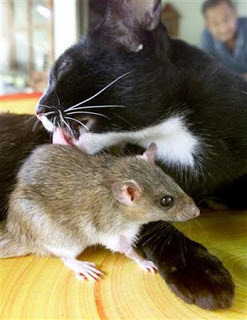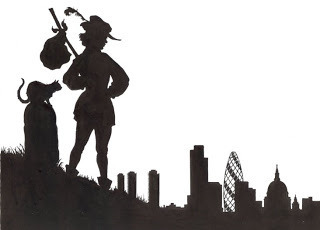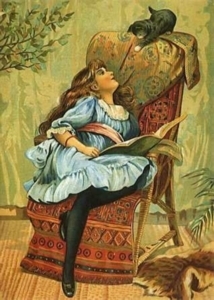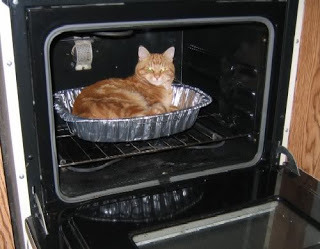Cat pies? -Victorian attitudes to cats.
Would it surprise you to learn that in Victorian times, if you were well off and owned a cat you were liable to
be called eccentric? This was because although cats were widely kept, it was by the poorer working
classes who needed them to keep down the vermin population in rodent infested lodgings. An RSPCA
report from the 1857 notes that:
'…almost every [working class] household has a cat.'
Indeed for a Victorian to own a cat was tantamount to advertising their impoverished circumstances, as illustrated by Dick Whittington. In the story the future Lord Mayor's companion was a cat, something the audience would have immediately understood as showing that Dick was a humble man from a poor background.
In his 19th century 'Survey of London Life' Booth observes that a householder's income was reflected by the condition of his cat.'People are poor indeed whose cats look starved. I have seen the Cats' Meat Man on his round in a very poor street and no less than a dozen cats were strolling around with tails confidently raised, awaiting their turns.' In such times, cats were generally not pampered like today's animals, far from it they were often cruelly abused. Alfred Rosling wrote in the 1850's:'No boy…would dream of passing a cat without throwing [a stone] at it.'But perhaps these poor animals were lucky just being stoned since there was a recognised problem with traders who trapped cats for their pelts. Victorian times were perilous for cats since it wasn't just their skins that were in demand, it was also their meat. In Charles Dickens' novel the Pickwick Papers, Sam Weller discusses 'Cat Pies' with Mr Pickwick: I [Sam Weller] lodged in the same house vith a pieman once…make pies out o'anything, he could. 'What a number o'cats you keep, Mr Brooks,' says I 'You must be very fond of cats' says I. 'Other people is,' says he a-winkin' at me…and vispering in my ear, 'don't mention this agin…but it's
In such times, cats were generally not pampered like today's animals, far from it they were often cruelly abused. Alfred Rosling wrote in the 1850's:'No boy…would dream of passing a cat without throwing [a stone] at it.'But perhaps these poor animals were lucky just being stoned since there was a recognised problem with traders who trapped cats for their pelts. Victorian times were perilous for cats since it wasn't just their skins that were in demand, it was also their meat. In Charles Dickens' novel the Pickwick Papers, Sam Weller discusses 'Cat Pies' with Mr Pickwick: I [Sam Weller] lodged in the same house vith a pieman once…make pies out o'anything, he could. 'What a number o'cats you keep, Mr Brooks,' says I 'You must be very fond of cats' says I. 'Other people is,' says he a-winkin' at me…and vispering in my ear, 'don't mention this agin…but it's
the seasonin' as does it,' says he, a-pointin' to a wery nice little tabby kitten, 'and I seasons 'em for
beefsteak, weal or kidney, 'cording to the demand.'


be called eccentric? This was because although cats were widely kept, it was by the poorer working
classes who needed them to keep down the vermin population in rodent infested lodgings. An RSPCA
report from the 1857 notes that:
'…almost every [working class] household has a cat.'

Indeed for a Victorian to own a cat was tantamount to advertising their impoverished circumstances, as illustrated by Dick Whittington. In the story the future Lord Mayor's companion was a cat, something the audience would have immediately understood as showing that Dick was a humble man from a poor background.

In his 19th century 'Survey of London Life' Booth observes that a householder's income was reflected by the condition of his cat.'People are poor indeed whose cats look starved. I have seen the Cats' Meat Man on his round in a very poor street and no less than a dozen cats were strolling around with tails confidently raised, awaiting their turns.'
 In such times, cats were generally not pampered like today's animals, far from it they were often cruelly abused. Alfred Rosling wrote in the 1850's:'No boy…would dream of passing a cat without throwing [a stone] at it.'But perhaps these poor animals were lucky just being stoned since there was a recognised problem with traders who trapped cats for their pelts. Victorian times were perilous for cats since it wasn't just their skins that were in demand, it was also their meat. In Charles Dickens' novel the Pickwick Papers, Sam Weller discusses 'Cat Pies' with Mr Pickwick: I [Sam Weller] lodged in the same house vith a pieman once…make pies out o'anything, he could. 'What a number o'cats you keep, Mr Brooks,' says I 'You must be very fond of cats' says I. 'Other people is,' says he a-winkin' at me…and vispering in my ear, 'don't mention this agin…but it's
In such times, cats were generally not pampered like today's animals, far from it they were often cruelly abused. Alfred Rosling wrote in the 1850's:'No boy…would dream of passing a cat without throwing [a stone] at it.'But perhaps these poor animals were lucky just being stoned since there was a recognised problem with traders who trapped cats for their pelts. Victorian times were perilous for cats since it wasn't just their skins that were in demand, it was also their meat. In Charles Dickens' novel the Pickwick Papers, Sam Weller discusses 'Cat Pies' with Mr Pickwick: I [Sam Weller] lodged in the same house vith a pieman once…make pies out o'anything, he could. 'What a number o'cats you keep, Mr Brooks,' says I 'You must be very fond of cats' says I. 'Other people is,' says he a-winkin' at me…and vispering in my ear, 'don't mention this agin…but it'sthe seasonin' as does it,' says he, a-pointin' to a wery nice little tabby kitten, 'and I seasons 'em for
beefsteak, weal or kidney, 'cording to the demand.'

Published on December 12, 2010 07:05
No comments have been added yet.
'Familiar Felines.'
Following on from last weeks Halloween posting, today's blog post looks at the unwanted image of cats as the witches familiar - from the Norse Goddess Freya to lonely women in the middle ages.
The full Following on from last weeks Halloween posting, today's blog post looks at the unwanted image of cats as the witches familiar - from the Norse Goddess Freya to lonely women in the middle ages.
The full post can found at:
http://graceelliot-author.blogspot.com
...more
The full Following on from last weeks Halloween posting, today's blog post looks at the unwanted image of cats as the witches familiar - from the Norse Goddess Freya to lonely women in the middle ages.
The full post can found at:
http://graceelliot-author.blogspot.com
...more
- Grace Elliot's profile
- 156 followers



